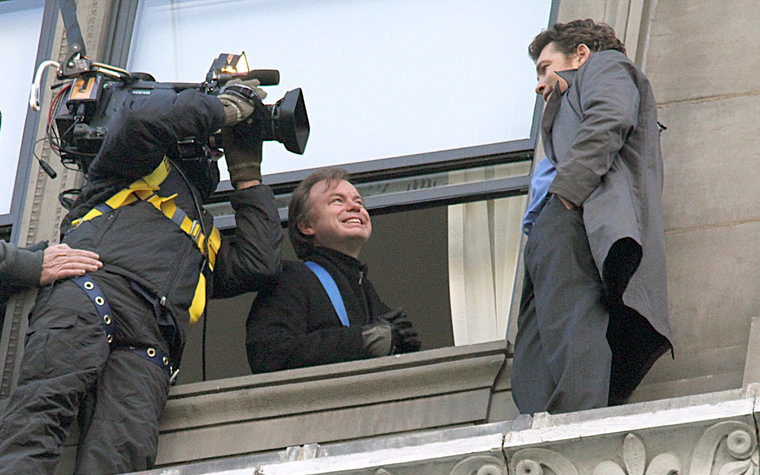Following the success of the Leaders of Luxury web series, we’re working with Robb Report once again. Continuing our look into the future of luxury through the eyes of those who are determining it, Jackie Caradonio, Travel Editor at Robb Report, uncovers the tools that great communicators need to sell their brand.
You’ve got a message. But can you deliver it?
We all know that communication is the key to success. So then why are so many of us so bad at it? Turns out, being able to effectively talk about your product or service isn’t quite so easy. But there are secrets out there that successful CEOs, entrepreneurs, actors, and performers use to keep their audience hanging on their every word. And the man behind those secrets is Michael Hopkins. For more than 20 years, the founder of Hopkins Media Training has been directing celebrities, editors, and high-level executives in the techniques of communication and delivery. Here, Hopkins shares with us the crucial tools that great speakers use to draw their audience in—and how everyone can apply them to their own professional success.
 What’s the most important thing we need to do in order to ensure that what we’re communicating—whether a sales pitch, a speech, or a presentation—will effectively reach our audience?
What’s the most important thing we need to do in order to ensure that what we’re communicating—whether a sales pitch, a speech, or a presentation—will effectively reach our audience?
The first thing you need to do when communicating something—anything—is to create a structure. Frame every conversation for the person you are speaking to. This not only helps you to be prepared with what you are going to say, but it also prepares your audience for what they are about to hear. You see this on all the news and entertainment shows: They give you a headline first, then a few highlights of what they are about to tell you. Once your audience knows what to expect, you know that they’re listening.
The second thing is connection: Find your connection to the story. Why are you excited about it? If you are pitching me a hotel or a service, you have to be excited about it and connected to it. If you’re not excited about it, the game is already over. Don’t waste an opportunity—tell me something meaningful. Sell it like you mean it. If you don’t mean it, people will sniff that out.
What’s your biggest advice when it comes to speaking to an audience or important client?
My biggest advice would be don’t try to wing it. If you try to wing it because you think it’s going to be more authentic, you are going to fall flat. I can give you all the speaking tips in the world, but then the work is on you to spend the time practicing, either in front of a mirror or with a friend. You can read something over and over in your head but until you stand on your two feet and say it out loud and get excited about it, you’re not prepared.
Tell us about the power of the pause.
The pause is a vital part of speaking that people don’t use often enough. Effective communication is all about intonation and pace. People tend to speak in what are essentially run-on sentences. When we’re communicating verbally, we need to use the same types of punctuation and grammar as we would when we write. The pause is the most important tool because it allows your audience to keep up with you and follow along with what you’re saying. It also keeps you in control: Put your foot on the gas, then brake. Are they still with you? If so, put your foot back on that gas.
It sounds like checking in with your audience is an important part of delivering a successful speech or pitch.
It’s so important to gauge the audience or person listening to you whenever you’re speaking. There’s this mentality that if you say it quickly, people won’t have time to lose interest. But if you rush through it, you miss the point. We’re so worried about presenting all of the information that we practiced, and the information that we think is important. But we always need to remember, what is the audience getting out of it? What are they listening for? Do they want that great trip or amazing experience? That’s why you’re there.
What’s one of the biggest communication mistakes that everybody makes?
Body language: How do I stand? What do I do with my hands? People feel self-conscious when all of the attention is on them, but I always bring them back to the importance of the connection. If you are telling a story, and you are excited about it—you are connected to it—you are authentically telling a story. You don’t wonder what do with your body. That’s why it so important to have that connection to every pitch, presentation, and performance because if you have that, you can lose yourself in it a bit. And everything else—your hand gestures, the way you stand—will fall into place.
What about social media? How can we use it as a successful communication and marketing tool?
Social media like Instagram is really just a shorter version of what you should already be doing, which is to tell a story. An Instagram or Facebook post still needs a story—there has to be an angle behind it. Why are you telling the story? Are you doing it to sell something—or are you doing it to get me excited about something? People can tell the difference. Think of yourself as a storyteller in everything you do, and people won’t be able to ignore you.
As a regular contributor for View from ILTM, Jackie will be sharing her insights on luxury and travel throughout the year. Check back next month for Jackie’s latest view.


